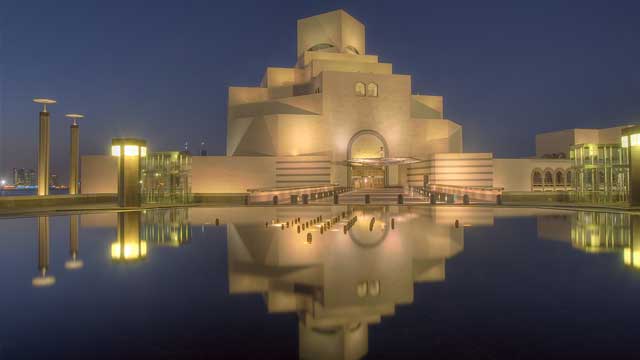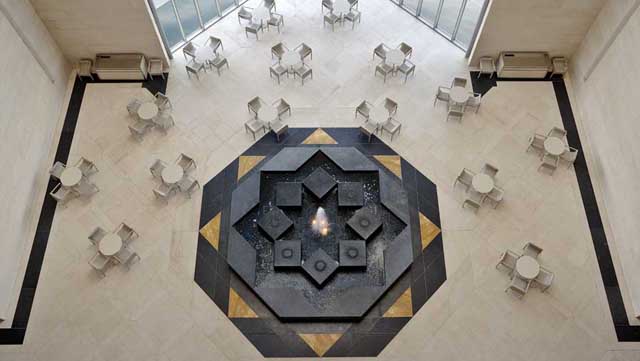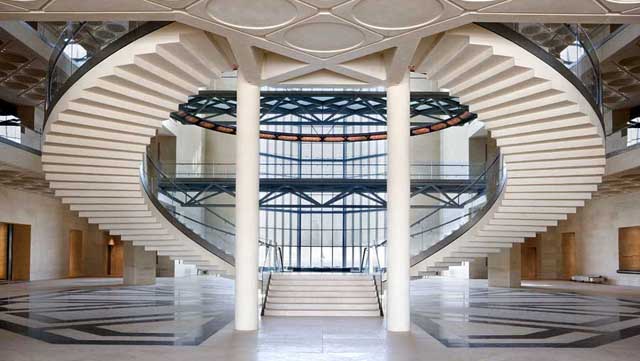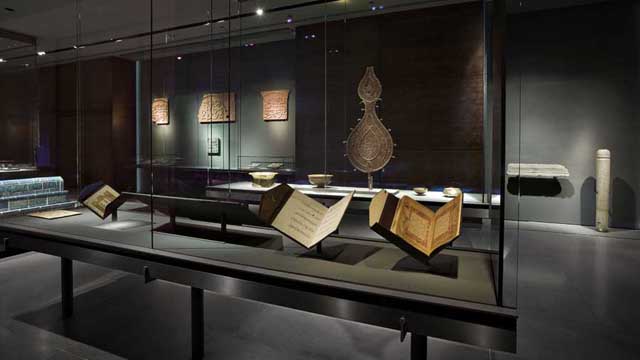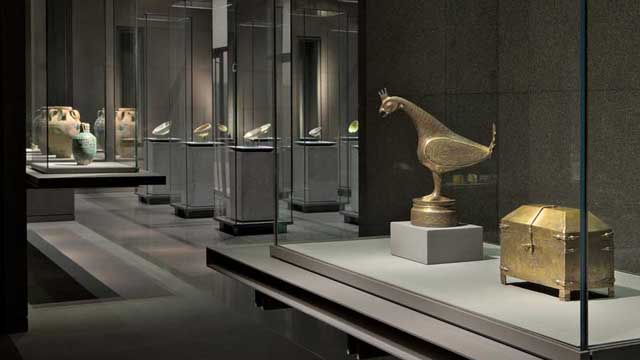Museum of Islamic Art
The Museum of the Islamic Arts, Qatar, is an imposing building set on an artificial building of Doha's Corniche. The building, which opened to the public in December 2008, showcases a selection of Islamic artefacts, many of which are both ancient and historically significant.
Design
Although the museum features Islamic Art, and is built using Islamic design, the building was actually designed by Chinese American architect Leoh Min Pei (more commonly known as I. M. Pei,) designer of the Louvre in Pyramid and one of the most celebrated architects in the world today.
Pei, who at 90 years old had to be lured out of retirement to undertake the work, then travelled across much of the Islamic world studying its architecture, and in designing the Museum I. M. Pei drew inspiration from Islamic buildings such as Ibn Tulun's mosque in Egypt (the inspiration for the actual architecture came from the 13th century sabil (ablutions fountain) of the mosque) and the Al Hambra Palace in Spain.
The result is an imposing white museum, consisting of a blend of modern and traditional styles, and designed so that the cubic shapes of the museum, which descend from the dome in changing geometric patterns, will interplay with the sun and the shadows.
To protect against the harsh sun, the heat and the salt heavy sea water, Pei selected a stone which could resist all these elements: the Shamisen stone from France. A crescent cape located in front of the museum offers further protection from the sea.
The interior is decorated with grey Porphyry stone and Brazilian lacewood, and the lights are kept dimmed to protect the treasures within.
Pei decided to locate the museum on an artificial island (a 60 meter causeway lined with palm trees links it to the Corniche) adjacent to Doha's port - he chose an island so that the museum would never be overshadowed by development on the sea front.
The project has a full size of 45,000 square meters, and is protected from the sea by a concrete crescent cape. Behind the museum a landscape of dunes and oases is being constructed to offer a backdrop to the stone clad construction.
Collection
The Museum showcases artifacts that the Al Thanis - Qatar's Royal Family - have been collecting for many years. The collection of artifacts for the Museum has stepped up in recent years, with vast sums being spent on Islamic Art, although more recently the buying has been hit by scandal over the vast sums spent.
As well as the Qatar National Collection of Islamic Art - a collection of metal work, ceramics, jewelry, woodwork and glass collected from three continents - the Museum will include 600 year old artifacts of ivory and silk inscribed with Islamic and Arabic inscriptions.
Examples of exhibits to be shown include panels lined with gold thread that decorated the imperial tents of Iran and Central Asia in the thirteenth century, as well as a curtain decorated with calligraphy that lined the walls of Al Hambra in fifteenth century Muslim Spain. Audio tours in different language accompany the exhibits, allowing staff to keep labelling to a minimum.
Specific exhibits include:
Ancient Quran
The collection includes several pages of ancient Qurans, one of which is thought to have been compiled just a few years after Mohammed's death.
None were compiled in his lifetime, so this must have been one of the earliest Qurans.
Christian Calligraphy
Another fascinating piece features the Virgin Mary with a baby Jesus - along with Arabic Calligraphy reading: "There is No God but God." This forms part of the Muslim profession of faith. Of course, monetheism is a belief shared by both religions, but it is fascinating to see Arabic/Islamic calligraphy used in this way by a medieval Christian painter.
The Book of Secrets
One of the most intriguing exhibits in the past the Book of Secrets. The book of secrets is an 11th century manuscript detailing over 30 mechanical wonders of the electronic world. The book is not a permanent exhibit: however a team of experts have been working on deciphering the contents in Doha. The result is an interactive CD rom which can be browsed by visitors to the museum.
See The Book of Secrets by DecodingTheHeavens.com for more information.
Address : Doha corniche
Opening Hours :
The Museum will be closed on the first day of Eid and Xmas.
Sunday: 10.30 - 17.30
Monday: 10.30 - 17.30
Tuesday: Closed
Wednesday: 10.30 - 17.30
Thursday: 10.30 - 17.30
Friday: 14:00 - 20:00
Saturday: 10:30 - 17:30
Staff
To help with the planning set-up and operation of the Museum, Qatar has retained the British Museum to act as consultants. The museum will also have a staff of 160, headed by Oliver Watson, author and former curator of Islamic Art at the Victoria and Albert Museum in London.
Amenities
The Museum has an excellent bookshop, with a good selection of volumes on art, Islamic Gardens and so on. As of yet there is no cafe - at least not unless you are a VIP visitor, in which case you can avail yourself of one on the fifth floor. A library is under construction, and there is also a children's art workshop.
The museum will eventually provide research facilities, support local education, and contain a library, auditorium and five star restaurant.
Museum Park
Outside the Museum there is mooring for private boats, as well as several traditional dhows. The Museum is set in a large park with well mantained gardens, and in the cooler months makes for a pleasant walk. Work is continuing on the park.





